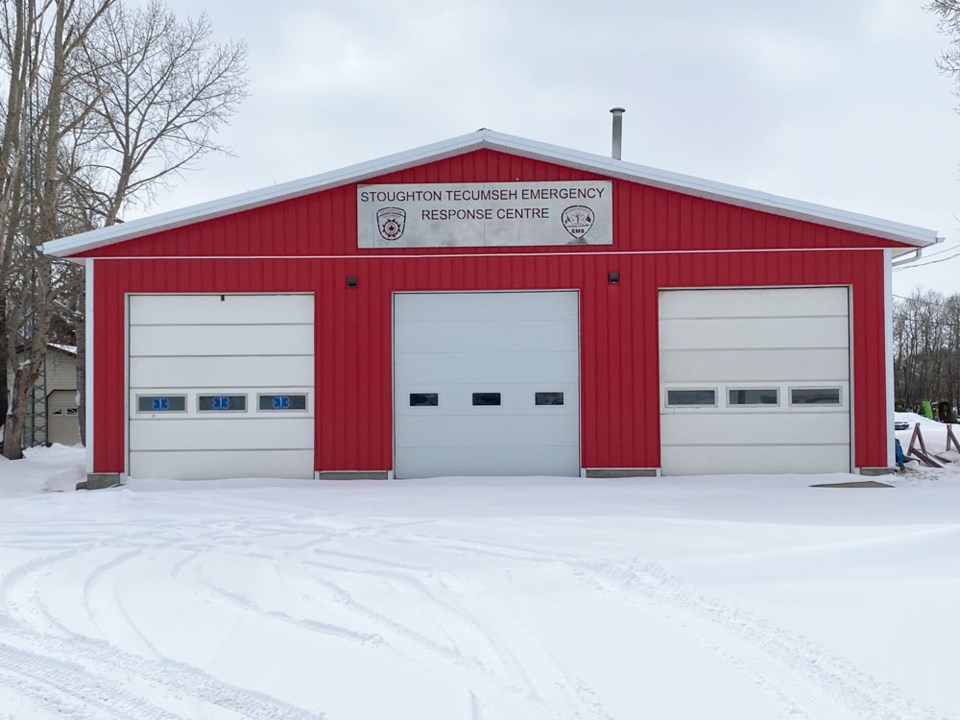STOUGHTON - At one point and time, we may have done volunteering at a local event.
We have a set date, a time and place for the event. We show up and do our shift, and next year volunteer again.
The Stoughton Tecumseh Emergency Response Centre also has volunteers. They are on a whole different level. Their time slots are never set and the dates are never known. Yet they are available 24 hours a day, seven days a week.
This fire department is run jointly by the Town of Stoughton and the R.M. of Tecumseh, but located in Stoughton, near the north end.
These brave men and women volunteer their time to save our homes from fire, or to rescue our family and friends from an accident. They do this because they feel it is their calling.
Pat Slater is the current fire chief for the Stoughton Tecumseh Fire Department. He has been with this service for 40 years and chief since 2005. With 22 active members and nine in reserve, volunteers are always needed.
“During the weekdays people are away working, and we could be short,” Slater said. “Evenings and weekends are always good, as people are usually home.”
Slater has lived in Stoughton for a majority of his life. He did leave for eight years to be in the military and at one time deployed in the Middle East. He worked on multiple vehicles during that time and is a mechanic. He owns Pat’s Autobody in Stoughton and continues to work on vehicles.
The fire hall received an addition three years ago and now has room to house all the trucks and equipment. They are working on a wall of recognition as well.
When a call comes in, the following three trucks go out on the call: the command truck, rescue truck and the pumper. No matter what, they attend.
The 50-foot ladder is massive, but thankfully it has not been in a rescue yet. Slater stated, “it’s better to have the equipment and never use it, than to need it and not have it.” A side by side, fitted with tracks, is another one of the pieces of rescue equipment needed. This one is for snow recoveries. The covered in sled attaches to it easily.
They just purchased another truck. The Mack truck holds a 4,000-gallon water tank. The F550 houses an 800-gallon tank, and two others have 300-gallon tanks. The smaller units are great for grass fires as they are more versatile on rough ground than the pumper truck.
Although the last year was an exceptionally dry one, they attended only to a few grass fires.
“It was a slow year, which is good,” he said.
A schedule is posted for the year. Two different members for each month are responsible for checking all the equipment weekly during their time, and it is an extensive list of checks.
Once a month they have training sessions.
“All training for new volunteers will be conducted by the department,” said Slater.
A two-storey unit is also inside with small windows framed in. These small windows are a challenge to get through when all geared up, as the suits are heavy. Slater stated, "It’s easy to get through a large window, but the small ones create the problems.”
Air tanks, when full, last 20 minutes. They are hydro evaluated every five years and checked weekly. The aluminum tanks will last a lifetime.
A grain bin kit is another unique piece of equipment, with all the wheat farmers have, this is necessary. It helps in the rescue of anyone falling into a grain bin.
Recently, two electric Jaws of Life were deemed to be a valuable purchase by the fire hall. These units are ready at the push of a button. A vehicle extrication course occurred just recently at the fire hall.
“The new vehicles create dangerous situations for our people, with all the bells and whistles. You do not just cut into a vehicle, like years ago,” Slater said.
In the command truck they have a program on their iPad that allows them to see where these dangers are before cutting. Slater went on to say, “They still need to use caution, when having to use the Jaws of Life.”
Calls to 911 go through a call centre in Prince Albert. From there the volunteers receive a text, a voice message and then a call. It takes five minutes from the time the call comes in for the volunteers to be in the trucks and on the road.
“No two calls are ever the same, so be prepared with the equipment you have,” said Slater.
In February 2020, Ray Coderre, Doug Turner, Randy Coderre and Pat Slater received a certificate for their long service through the Saskatchewan Urban Municipalities Association.
After the tragic Humboldt bus crash, Slater said, “We needed to be prepared and we aren’t for something like this.” So, he gathered all the nurses’ names in the area, along with all retired nurses, just in case.
For safety tips, Slater said, “Make sure your carbon monoxide and smoke alarms are up to date and placed properly. Have at least one fire extinguisher on hand, and an escape route planned.”
Although the last year was slow, that can change in a blink of an eye.
Slater commented, “I’m very proud of our team and truly grateful for what they do.” Slater went on to say, “Always prepare for the worst, but always hope for the best.”






